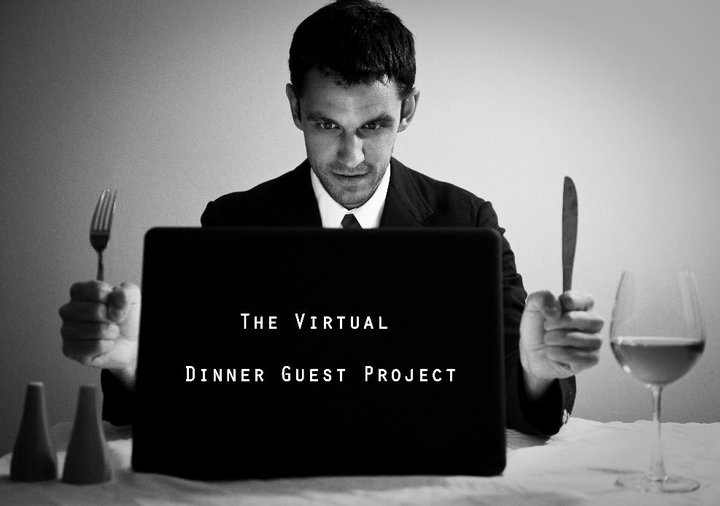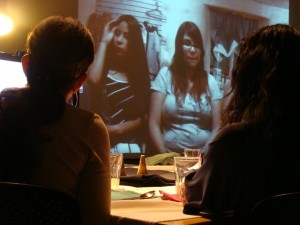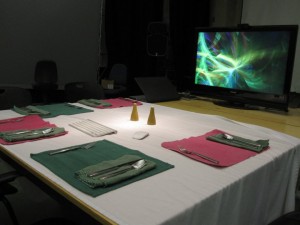
photo credit: Michael Karsh
The Virtual Dinner Project: Guess Who’s Coming?
The Santa Fe-based Virtual Dinner Guest project is only in its first year, but its conception traces to 2007 on the West Bank. There, during a five-month field practicum in international conflict resolution while taking his master’s degree, Eric Maddox first began to consider the role of direct dialogue on cross-cultural understanding.
The result of that trip is Maddox’s 48-minute documentary film, 48 Generations, for which Maddox interviewed older-generation survivors of the 1948 war, as well as their descendants, in order to “trace the oral histories,” Maddox says.
The experience was the start of Maddox’s quest to extend digital storytelling into a real-time interface that would promote cross-cultural understanding and citizen diplomacy.
For Maddox, the documentary film—which premiered at the 2009 Santa Fe Film Festival—was “a mechanism for promoting dialogue across borders, across conflict, across cultures,” and, he says, in many ways a powerful one. But the project also made him realize filmmaking’s limitations.

photo credit: David Forlano
“You are, in a sense, creating a dialogue, but it’s an indirect dialogue,” he says. He began to wonder: “What about creating opportunity for real time discussion between parties in conflict?” with the ultimate goal of showing that people are not just “one political identify, one religious identity.”
Enter Skype. Maddox had used Skype during his time in the Middle East to talk with his girlfriend. The technology could create real-time communication between parties in conflict, he realized. After Maddox’s visa application to Iran—to make another interview-based documentary—was rejected, the idea was heightened. He wanted to find a project that would allow for further cultural dialogue, and be acceptable even in countries with limitations on the press.
“I needed a forum,” he says, “one that was universal and without cultural bias, and transparent enough that it could be done anywhere.”
Enter the dinner table.

photo credit: Katie Cook
The first virtual dinner was held in July 2011 between Santa Fe and Ciudad Juárez, Mexico. In October, the virtual dinner occurred with Kampala, Uganda, and another virtual meal with Juárez happened in November. Maddox is working on arranging “meals” with Pakistan and Liberia in the coming 12 months. Even more ambitiously, he intends to travel to the Middle East and set up dinners on that end to coincide with the anniversary of the Arab Spring—a 2011 sequence that also inspired the Virtual Dinner Guest project.

photo credit: Katie Cook
The actual dinners are fairly simple. Participants from each location sit around the dinner table, and that table extends across borders via Skype and video screens. In Santa Fe, the dinners have been hosted at the Santa Fe Complex, Zane Bennett Contemporary Art and Epazote Restaurant. Ideally, US participants eat the food of the country with whose citizens they are virtually dining. Conversations last from 60 to 90 minutes, during which audience members also have the opportunity to grab a seat at the table and participate.
While the project incorporates elements of art as social change (VDG was a finalist for SITE Santa Fe’s SPREAD micro-funding grant in October), Maddox sees the project also as a legitimate conflict-resolution technique. “I would even say it’s a kind of diplomacy,” he says—citizen diplomacy in which “real people talk to one another.”
Simple, but Maddox’ aspirations for the project are anything but. At a concrete level, the project is geared toward “capacity building,” in which civil and humanitarian organizations on both sides grow stronger through the connections made, which lead to future initiatives. Maddox looks for partner organizations in other countries that work “very close to the problems they are trying to solve.”
But the intangibles were the inspiration for the Virtual Dinner Guest, and continue to guide Maddox’s thinking and principles as he works on staging a year of travel abroad and multiple dinners with people who might otherwise remain obscured through the filter of media or even completely unknown. Ultimately, VDG aims toward humanizing people from countries with conflict, as a way to “look beyond the headlines.” Or, as the VDG websites notes: “is harder to kill and ignore those whom we have seen, spoken with and broken bread with.”
